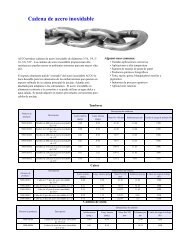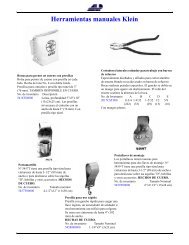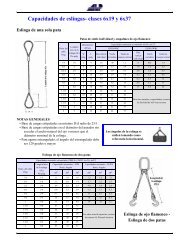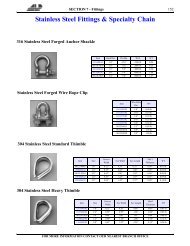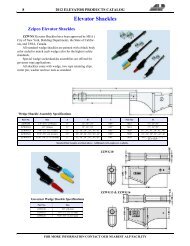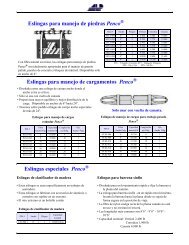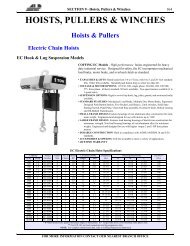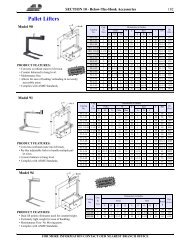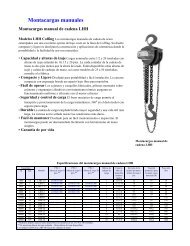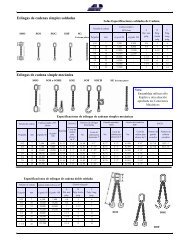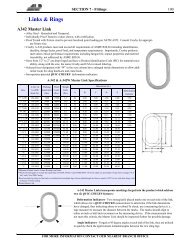General Products - ALP Industries Inc.
General Products - ALP Industries Inc.
General Products - ALP Industries Inc.
- No tags were found...
You also want an ePaper? Increase the reach of your titles
YUMPU automatically turns print PDFs into web optimized ePapers that Google loves.
SECTION 1 - Wire Rope 6Maintenance Records. Equally important in inspectingplastic-infused ropes is maintaining accurate service records.The service records of previous ropes will provide a guidelineas to the expected life of the rope. However, they shouldnot be used alone or only in conjunction with visual inspectionsdue to the number of variables which exist, includinginstallation, spooling and manufacturinng practices. Maintenancerecords must be used in combination with both visualand physical inspection techniques to be truly of value indetermining the remaining life of the rope.Overall, perhaps the most important inspection techniqueis recognizing the limits of wire rope. While it’s true thatcompacted and plastic infused ropes are more durable,neglect and abuse will still quickly end the rope’s life. Thereis no substitute for proper installation, handling and inspectiontechniques in combination with a preventative maintenanceprogram.Compacted Rope. Die drawn and swaged ropes fall intothe compacted category. Compacting serves several purposes.By flattening the outer wires, metallic area increasesallowing for a higher breaking strength as well as improvedcrushing and abrasion resistance. In addition, the compactionminimizes interstrand nicking and thereby improvesfatigue resistance.In the inspection of compacted rope designs, again it isimperative to follow the basic inspection guidelines and useboth visual and actual measuring techniques to determine theremaining life of the rope. In fact, actual measuring techniquesare very important when inspecting these ropes.While corrosion is relatively easy to visually determine,diameter reduction may not be due to the compacted rope’sappearance. Therefore the inspector must regularly measurefor diameter reduction and closely examine the rope for laylengthening. Measurements must be recorded and the ropemonitored for sudden variations.By and large the most difficult retirement criteria to determinein compacted ropes is wire breaks. These breaks maynot protrude from the rope due to the compaction and can beeasily overlooked. Because of this, the inspector mustslowly and carefully examine the rope, especially in thoseareas passing over drums and sheaves or in areas whereproblems existed in previous ropes.A wire break may appear as nothing more than a crack inthe wire, and again can be easily overlooked. If the inspectornotes a “flaw” in a wire, it should be carefully checked. Theinspector should carry some type of magnifying device todetermine if a flaw is actually a break. If a break hasoccurred, thoroughly check the area for additional breaks,both on the crown and in the valleys. Remember, valleybreaks in round strand ropes are difficult to determine; compactiononly increases the difficulty. The inspector must beslow and methodical in inspecting compacted ropes; a quickcheck will reveal nothing.FOR MORE INFORMATION CONTACT OUR NEAREST BRANCH OFFICE





